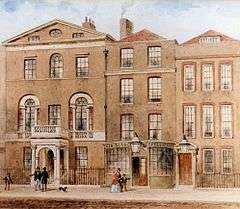Old Slaughter's Coffee House
| Old Slaughter's Coffee House | |
|---|---|
 | |
| Former names | Slaughter's Coffee House |
| Alternative names | The Coffee-house on the Pavement |
| General information | |
| Status | Demolished |
| Location | St. Martin's Lane |
| Address | 74–75 |
| Opened | 1692 |
| Demolished | 1843 |
Old Slaughter's Coffee House was a coffee house in St. Martin's Lane in London. Opened in 1692 by Thomas Slaughter, it was the haunt of many of the important personages of the period. The building was demolished in 1843 when Cranbourne Street was constructed.
History
It was opened in 1692 by Thomas Slaughter and so was first known as Slaughter's or the The Coffee-house on the Pavement, as not all London streets were paved at that time. It was at numbers 74–75 but, around 1760 after the original landlord had died, a rival New Slaughter's opened at number 82 and the first establishment then became known as Old Slaughter's.[1]
It was patronised by players of games including chess, draughts and whist. Notable players included Abraham de Moivre, Benjamin Franklin and Philidor.[2][3] It was also popular with artists of all kinds – architects, painters, poets, sculptors, &c. This artistic community included Dryden, Gainsborough, Hogarth, and Roubiliac.[1] Foreigners such as Frenchmen were often there and Boswell reports Dr Johnson's comment on this around 1780:[4]
His unjust contempt for foreigners was, indeed, extreme. One evening, at Old Slaughter's Coffee-house, when a number of them were talking loud about little matters, he said 'Does not this confirm old Meynell's observation, For any thing I see, foreigners are fools?'— James Boswell, The Life of Samuel Johnson, LL. D.
Henry Fielding was a regular and nicknamed the head-waiter "Sock". Sock was said to be the bastard son of the popular comedian, James Spiller, and had a similar talent for droll wit. On one occasion, he partook of a customer's punch while bringing it and excused this by saying that he had spilled it. Thereafter, Sock was also known as the "Punch Spiller".[5]
It was used as a meeting house and the Society for the Prevention of Cruelty to Animals, which subsequently became the RSPCA, was founded there in 1824. The meeting was organised by the Revered Arthur Broome and chaired by Sir Fowell Buxton. There were eight other gentlemen attending including "Humanity Dick" – Colonel Richard Martin – who had successfully campaigned for the Cruel Treatment of Cattle Act in 1822 but whose latest bill for the Prevention of Cruelty to Animals, had been defeated in the Lords that day. Other MPs attending included Sir James Mackintosh and William Wilberforce.[6]
The premises were demolished in the winter of 1843 when Cranbourne Street was constructed.[7]
See also
References
Citations
- 1 2 Timbs 1868, p. 270.
- ↑ Price 2015, p. 72–95.
- ↑ Bellhouse 2011, p. 30.
- ↑ Boswell 1833, p. 247.
- ↑ Greybeard 1821, p. 542.
- ↑ Phillips 2003, p. 179.
- ↑ Wheatley 1891, p. 484.
Sources
- Bellhouse, David (2011), Abraham De Moivre: Setting the Stage for Classical Probability and Its Applications, CRC, ISBN 9781568813493
- Boswell, James (1833), John Croker, ed., The life of Samuel Johnson LL. D., vol. 2, George Dearborn
- Dale, Andrew (2006), Most Honourable Remembrance: The Life and Work of Thomas Bayes, Springer, ISBN 9780387215617
- Greybeard, Cockney (25 August 1821), "Sketches of Society – Wine and Walnuts", The Literary Gazette and Journal of the Belles Lettres, Vol. 5 (240)
- Guard, Richard (2012), "Old Slaughter's Coffee House", Lost London, Michael O'Mara, ISBN 9781843178965
- Hibbert; Weinreb (2008), "Old Slaughter's Coffee House", The London Encyclopaedia, Pan Macmillan, ISBN 9781405049245
- Phillips, Peter (2003), Humanity Dick: The Eccentric Member for Galway, Parapress, ISBN 9781898594765
- Price, Bill (2015), "Coffee House Chess", The History of Chess in Fifty Moves, Apple, ISBN 9781845436094
- Timbs, John (1868), Curiosities of London, Longmans
- Wheatley, Henry (1891), London Past and Present, Vol. 2, John Murray, ISBN 9781108028073